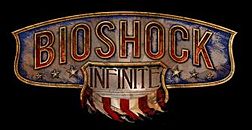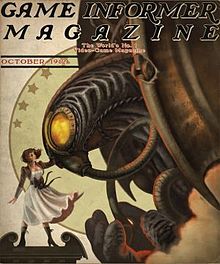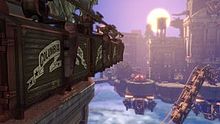- BioShock Infinite
-
BioShock Infinite 
Title cardDeveloper(s) Irrational Games Publisher(s) 2K Games Designer(s) Ken Levine Series BioShock Engine Modified Unreal Engine 3 Platform(s) Microsoft Windows
PlayStation 3
Xbox 360Release date(s) 2012[1][2] Genre(s) First-person shooter Mode(s) Single-player BioShock Infinite is an upcoming first-person shooter video game, and the third game in the BioShock series. Previously known as "Project Icarus", it is being developed by Irrational Games for a 2012 release on the Microsoft Windows, PlayStation 3 and Xbox 360 platforms.[1] BioShock Infinite is not a direct sequel or prequel to previous BioShock games, taking place in an earlier period and different setting, though it features similar gameplay concepts and themes. The player controls a former Pinkerton agent, Booker DeWitt, as he attempts to rescue a woman named Elizabeth trapped aboard the collapsing air-city Columbia in 1912.
Contents
Plot
Setting
The primary setting of BioShock Infinite is a city suspended in the air by giant blimps and balloons, called "Columbia", named in homage to the female personification of the United States. Unlike the secret development of the underwater city of Rapture used as the settings for BioShock and BioShock 2, Columbia was built and launched in 1900 by the American government to much fanfare and publicity. The city was meant to symbolize the ideas of exceptionalism;[3][4] the reveal trailer for the game alludes to the 1893 Worlds Fair which is historically considered to be the emergence of American exceptionalism.[5] On the surface, Columbia appeared to be designed as a floating "Worlds Fair" that could travel across the globe; however, some time after its launch but before the game's events, the city was revealed to be a well-armed battleship, and became involved in an "international incident" by firing upon a group of Chinese civilians during the Boxer Rebellion.[6][7]
The city was disavowed by the United States government, and the location of the city was soon lost to everyone else.[6][8] The city became, as described by Nick Cowen of The Guardian, "a kind of roaming boogieman moving from place to place and imposing its will on people below".[9]
As a result of the city's isolation, a civil war eventually broke out on Columbia between different factions of citizens, each trying to seize control of the city from the powers-that-be.[10] At the time of the game's events, only two main factions remain. One group are the Founders, the remnants of those retaining power over the city led by Zachary Hale Comstock. This is the city's ruling class, which seeks to keep Columbia purely for American citizens while denying foreigners the same privileges. The other is a group named Vox Populi (Latin for "voice of the people"), a rag-tag resistance group, led by Daisy Fitzroy, opposed to the ultranationalists. The Vox Populi is formed from several factions with similar ideologies that fought to seize control and restore the rights of Columbia citizenship to all. However, years of war and struggle have driven the Vox Populi to fight the powers-that-be solely out of blind hatred, resulting in more violent and brutal methods and leading to subfactions in the group.[10]
Like Rapture, Columbia is considered a dystopia, but with signs present suggesting a theocratic government taking control at some point, and similar racial-purification concepts such as Nazism, jingoism, and xenophobia.[11][12][4][13] One of the items in the press packages for the game included a tag that would purportedly be worn by immigrants aboard Columbia, requiring those of non-European descent, which includes Papists, Gypsies, Irish and Greeks,[13] to list out numerous details, including religious affiliation and data relating to eugenics; another item was a Columbia propaganda poster that warned "We must all be vigilant to ensure the purity of our people."[13] Columbia has been compared to a cross between steampunk and the Star Wars Bespin cloud city,[12] as well as the airships of Final Fantasy settings[11] though Irrational's Ken Levine has compared the weaponized city to the Death Star.[14]
Plot
The events of the game take place in 1912. The player assumes the identity of Booker DeWitt, a disgraced former agent of the Pinkerton National Detective Agency, who was dismissed for behavior beyond the acceptable bounds of the Agency. He is hired by mysterious individuals, aware of Columbia's location, and tasked to infiltrate the air-city and rescue a young woman named Elizabeth, who has been held aboard the air-city for the last twelve years.[6][12] Though DeWitt finds Elizabeth easily enough, he quickly discovers that Elizabeth is central to the civil war raging in the city as each faction seeks to use Elizabeth to turn the tide of the conflict in their favor, forcing DeWitt and Elizabeth to trust each other in order to escape.[8][10] Elizabeth also seeks to understand the powers that she has been given, believing Comstock to be responsible, and refuses to leave Columbia until she learns the truth.[9] To complicate matters, the pair is chased by Songbird, a large, robotic bird-like creature who had been Elizabeth's friend and warden over the last twelve years of her imprisonment.[15][16] Songbird was designed by its creator to feel betrayal should Elizabeth escape, comparable to an abusive spouse, according to Hilary Goldstein of IGN, and Elizabeth notes she "would rather be killed than be recaptured by Songbird."[16]
In addition to the internal strife, Columbia is ravaged by tears in the fabric of space-time.[16][17] A strange shimmering effect as seen by DeWitt causes momentary changes to pictures, banners, and people, representing the nearby presence of a tear.[15] The tears have brought seemingly anachronistic elements into the Columbia of 1912; for example, an early gameplay demo footage features a record player in a bar plays a woman singing the lyrics to Tears for Fears' "Everybody Wants to Rule the World".[18] 1UP.com's preview of the 2011 E3 game demonstration denotes that at one point, DeWitt and Elizabeth find themselves in 1983, evident by a movie marquee showing Revenge of the Jedi (the original working name for Return of the Jedi), a result of a misfire of Elizabeth's powers involving tears in the fabric of space-time when she tries to help revive a horse.[17][9]
Though the game takes place before the events of the previous two BioShock games (occurring in 1960 and 1968, respectively), Irrational Games has not confirmed if BioShock Infinite shares the same universe with these titles; Ken Levine left the question of the possibility unanswered in an interview stemming from the game's announcement.[19]
Gameplay
BioShock Infinite is a first-person shooter with role-playing game elements similar to the previous two games. As DeWitt, the player moves about the various structures of Columbia using a grappling hook, a series of railways connecting the buildings called the Skyline, and other transport means to search for Elizabeth. The player will gain weapons which can be used in numerous ways within the environment, including on the Skyline, to defeat enemies.[20] DeWitt gains powers and abilities by using vigors and nostrums that are found through Columbia, the equivalent of BioShock's plasmids and tonics. Vigors grant activated powers such as telekinesis, electricity manipulation, or animal control (as seen by the manipulation of a flock of crows within the gameplay demo), while nostrums are passive abilities that can improve the player's strength or damage resistance. Unlike BioShock in which the player was able to use special Gene Banks to alter the loadout of plasmids and tonics they had, the choice to imbibe a certain vigor or nostrum is permanent and cannot be changed later in the game, placing emphasis on the consequences of the player's choices throughout the game.[4][15] Infinite does not use EVE, the equivalent of magic points, for powering abilities gained by vigors or nostrums. Each container of vigor has a limited number of charges in it, and while more can be found around the game's environment, the player can only carry a limited number of vigors into battle, with more powerful vigors containing fewer charges.[21] Nostrums are permanent changes to the character and cannot be removed once used. These come in two types, stable and unstable varieties, the latter referred to as "potlucks". Stable nostrums are more expensive, but the player knows exactly what effect applying the nostrum will gain them. Unstable nostrums are cheaper or can be found lying around the environment, but upon use, require the player to select one of four random effects to alter their character, an idea inspired by Heroes of Might and Magic according to Levine.[21]
Once reunited with Elizabeth, who also has a set of such powers, the player must work together with her to escape Columbia. For example, Elizabeth can create a localized rainstorm on foes, which the player, as DeWitt, can then fire upon with an electricity-based attack, electrocuting the foes.[6] The player will not be directly in control of Elizabeth, but instead she will react to the player and the current situation in a manner similar to the AI Director in Left 4 Dead, according to Levine.[20] However, using Elizabeth's powers also harms her, an action compared to the choice of killing or saving the Little Sisters from the previous games.[12] Elizabeth also has the ability to interact with the tears in the fabric of space-time, pulling objects from the other side to use within Columbia, escaping from battle through these, or repairing them.[16] The player will need to protect Elizabeth, but will not need "to babysit and hand-hold" her through the game.[22] Levine has stated that working with Elizabeth in the game is "in no way, shape, or form is this an escort mission", identifying that players reacted negatively to a late-game stage in the original BioShock in which they were tasked to protect a Little Sister.[23]
Several different forces are at work opposed to the player's progress within the city.[3] Furthermore, the player and Elizabeth are chased by both Songbird (sometimes simply referred to as "Him"), who is attempting to snatch Elizabeth from the player, and the Handymen (originally named Alpha), robotic-like monsters housing a human heart and head and with the ability to heal weaker units.[15][24][25][16]
The Skyline is a rail-based system (originally designed for moving cargo around Columbia but later used for personnel transport) similar to the concept found in the Ratchet & Clank games and described by Levine as "a roller coaster, over another roller coaster, over another roller coaster";[22] players activate a wrist-mounted tool that DeWitt and other enemies wear to jump and hang onto the self-powered tracks. Players can jump onto, off of, and between Skyline tracks at any time, and may face enemies that use the system to attack; the player can use weapons in DeWitt's free hand to defend the character. The freedom of movement along the Skyline allows for several varieties of combat, including flanking, cover, and area-of-effect attacks through creative uses of the system.[22][26]
Irrational Games has stated that the game's set pieces are not heavily scripted; this statement was made in response to reaction to a gameplay preview video released during the week of September 21, 2010, which, within ten minutes, demonstrated numerous elements of the game. The development team called the game's pacing "like BioShock 1", and that while there will be some scripted set pieces, the developers want the player to be able to explore Columbia at their own pace.[27] Unlike Jack or Delta, the silent protagonists of BioShock and BioShock 2 respectively, and who are guided by radio commands from a third party, DeWitt will be a vocal character, with dialogue designed to aid the player in leading DeWitt to complete his mission.[15]
At the present time, Irrational Games has not committed to including a multiplayer element within the game. While the team will experiment with concepts for a multiplayer component, Levine has stated that they would only proceed forward if it had elements not otherwise found in multiplayer games like Halo or Call of Duty.[28][29]
During Sony's E3 press conference on June 6, 2011 creative director Ken Levine announced on-stage that BioShock Infinite will support the PlayStation Move.[30] Though some reports believed that a new Move controller would be produced for the game based on information from Sony, 2K Games debunked these stories, stating that no new hardware is being developed for the game.[31]
Development
Though BioShock Infinite shares the same name with the other two games, Levine has stated that this is a new direction, and was coy to answer if they shared the same universe.[19] Levine referred to the term BioShock not as a specific location or setting, but a concept conjoined by two ideas: the exploration of a fantastical setting, and the use of a large number of tools and abilities in creative manners to survive.[14] Levine affirmed that with the similarities between the games, "It would be dishonest to say this is not BioShock".[20] Similarly, Timothy Gerritsen, Director of Product Development, stated they wanted to keep the feel of the BioShock experience but still consider Infinite to be a new intellectual property; as a means to sever the implied connection to the previous games, the teaser purposely shows a Big Daddy figurine being crushed at the onset.[32] This was furthered by the selection of the word Infinite as part of the title, to reflect the "many possibilities" they wanted to explore with the BioShock concept.[32]
Story and setting
If you think about the founding principles of the United States, if you think about the Declaration of Independence and the Constitution and the Bill of Rights, what's interesting to me is how two different people can look at the same set of documents by a single group of writers and come away with entirely different opinions about what those writings mean-so different that they're willing to kill each other over them.
Irrational had been working in secrecy on Infinite for two and a half years since completing the original BioShock;[34] 2K Games gave them the freedom to develop their sequel at will.[32] For the first six months of development, the team prototyped several possible ideas to brainstorm on what concepts would be effective for the next game.[35] The idea of the air-city came early in the development. The open-air environment gave them an opportunity to use color schemes that sharply contrasted with the darker palettes that were a staple of their earlier games.[19] Even then, their initial designs of the flying city were darker and closer to Art Nouveau, making the game world too claustrophobic and appearing similar to the city of Rapture. The period of American exceptionalism allowed them to create a brighter, expansive system.[36]
According to Irrational's Ken Levine, the name "Columbia", in reference to the female figure that personifies the United States, and the idea of American exceptionalism did not come about until six to eight months before the game's reveal.[3] An early concept was to depict a group of technology geeks against a band of luddites, but Levine found that such conflict exists "only in shades of reality" and wasn't compelling enough.[37] Instead, the Irrational team recentered on the idea of American Exceptionalism, a tangible concept that continues to be repeated throughout history.[37] The idea came to Levine after watching a documentary about the late 19th century, which quickly caught on with the rest of the team.[19] In particular, Levine pointed to one quote of U.S. President William McKinley on the eve of the Philippine–American War, which spoke to the need of America to "uplift and civilize and Christianize" the natives of the Philippines.[13] Though the accuracy of the quote is disputed, Irrational's lead artist Shawn Robinson noted that BioShock Infinite's goal is "not to teach any history", but felt such historical aspects helped to ground the work's fiction.[13] Levine stated that in the same manner that BioShock was not built specifically around objectivism, Infinite is not built around jingoism, but only uses the concepts to help set the stage to tell the story of individuals caught up in the conflicts.[38] Levine considered how the founding documents of the United States can be interpreted in several ways, leading to conflict between those that hold various interpretations of those ideals, leading to Infinite's different factions.[33] Figureheads of the powers-that-be like Saltonstall are based on both historical and present-day nationalistic personalities, seeking to put the needs of America before others; The Vox Populi were based on historical factions that often splintered into small, independent groups that undertook violent actions, such as the Red Army Faction from the 1970s and the Animal Liberation Front and Earth Liberation Front of present day.[10] During the course of the game's development period, the series of "Occupy" protests occurred across several cities; Levine, comparing these protests to other historical ones already incorporated into Columbia's history, used the real-time events to refine the game's story. Specifically, due to the nature of the various decentralized groups involved with the "Occupy" protests, Levine was able to define how the Vox Populi group would grow from its haphazard beginnings.[39]
Propaganda such as the British poster for World War I recruitment (left), inspired much of Columbia's propaganda (right) developed by Irrational.[34]The Irrational team reviewed much of the American culture and propaganda at the turn of the 20th century, using the artwork to create some of the in-game posters.[38][40] Levine commented that at the time, such imagery was "really subtle", and considered that their re-envisioning of these posters within Columbia was "a great way to communicate ideas visually".[34] Other sources of inspiration for the game's art included photographs from before and after the 1906 San Francisco earthquake, and from Sears-Roebuck catalogs from the turn of the century.[41] Another source of inspiration for the art style was developed by considering Infinite to represent "The Fourth of July, 1912", just as BioShock resonated with the theme of "New Years Eve 1959". By selecting this hypothetical date, the team quickly identified films to draw imagery from, like The Music Man, Meet Me in St. Louis, and Hello, Dolly which exhibited ideal views of Americana at the turn of the 20th century.[15] The bright, open-air environments of Columbia presented a challenge to the team to keep aspects of the horror genre within the game; Levine stated they took some inspiration from Stanley Kubrick's The Shining and David Lynch's Blue Velvet, transforming an "antiseptic environment" into the "scariest ******* place [one's] ever seen".[26][33]
One of the game demonstrations showed Elizabeth accidentally opening a tear into a 1980's setting after trying to revive a fallen horse. This setting was in contrast to their initial idea, a woodland glade, which Levine felt wasn't "striking or different enough" than the rest of Columbia. Instead, they borrowed assets from a previous project that, according to lead artist Shawn Robertson, Irrational was "literally about to throw away", finding the contrast and abrupt differences from the Columbia setting helped to emphases the use of tears in the game.[37]
DeWitt will be voiced by veteran voice actor Troy Baker, while Elizabeth will be voiced by actress Courtnee Draper.[42]
Technical and gameplay development
According to Levine, the team had to revolutionize their previous work on the BioShock game in order to realize Columbia, including both indoor and outdoor settings that take place thousands of feet above the ground.[43] The original BioShock engine, a modified Unreal Engine 2.x, was inadequate for their vision, and so they chose to work with Unreal Engine 3, modifying it with their own lighting engine and means to simulate the movement and buoyancy of the buildings.[32] The development team found that the implementation of open spaces created new gameplay options for the player, such as deciding between long-ranged attacks or finding a means to move in for short-range or melee combat.[22] While Irrational had followed 2K Marin's work on BioShock 2, Infinite does not include any further improvements that 2K Marin had made on the original engine.[32] According to Levine, all assets of Infinite are created from scratch.[8] The original BioShock received some criticism from PlayStation 3 owners, who found the port from the native Windows and Xbox 360 developed by a separate studio, Digital Extremes, to be lackluster. To address this, Irrational Games has stated that the PlayStation 3 version of Infinite will not be a port, as that version is being developed in-house simultaneously with the Windows and Xbox 360 versions.[44]
One challenge facing Irrational was identified from BioShock, in which players, once equipped with specific plasmids and weapons, could complete the game without having to alter their weapons; Levine quotes the saying "When all you have is a hammer, everything looks like a nail" to describe how they found players were able to complete most of BioShock using an Electrocution plasmid and a shotgun.[22] Irrational wanted instead to create situations through Infinite's weapons and powers that allowed the player to progress to some point with certain combinations but then would be forced to learn new possibilities that Irrational had designed within the game.[32] The team developed a variety of enemies that would have certain strengths and weakness that would force the player to experiment and work with all their available tools given to them.[22] This was further enhanced by the inclusion of Elizabeth, who has powers that can be used in conjunction with DeWitt's to achieve more impressive results but that strain her powers and giving choice to the player as to when to use her.[32] The inclusion of Elizabeth also served to better extend Irrational's vision of storytelling first-person shooters and to avoid other tropes used in similar games that have become "long in the tooth" such as receiving information over a radio or from someone on the opposite side of a window; according to Levine, having Elizabeth as a person working aside the player-characters helps to make the game "feel more grounded in humanity".[34] In contrast to the silent Jack from BioShock, the player character Booker is also given a voice, a decision to avoid complacency with the "silent protagonist" motif as well to have face-to-face interactions with other non-player characters instead of being told what to do over a radio or separated by a barrier.[33]
Players in Infinite will revisit areas from earlier in the game, in the same manner they did in BioShock. However, to create a better narrative, the Irrational team borrowed ideas from Batman: Arkham Asylum, a similar open-world game where players, on return to previous areas, would find new elements advancing the plot and gameplay.[45]
The team wanted to capture the aspect of BioShock where not every non-player character would immediately be aggressive towards you; Levine discusses a situation in Infinite where the player character walks into a crowded bar and cannot immediately tell the disposition of the non-player characters towards the player.[8] Levine compared this to the introduction of the Big Daddy in BioShock, giving the player several opportunities to view but not engage the characters so they would understand that there are several possible outcomes depending on what approach they used when they did have the ability to engage one.[46] As Infinite contains numerous groups in internal conflict with each other, the player will be given the opportunity to learn how to utilize different non-player character agents to progress in the game.[46] Irrational wanted to make sure consequences of the player's actions were reflected in the game; part of this is through the strain on Elizabeth when using her powers, but through altering the suspended city, they are able to change the environment in response to the player's choice and force the player to consider different tactics.[8]
Promotion
Prior to its announcement on August 12, 2010, Irrational Games has used the moniker "Project Icarus" to describe their next game, creating a teaser site in late July 2010.[47] Over the weeks leading to the announcement, the animation on the teaser site slowly built up to an animated infinity symbol on the day prior to the announcement.[48]
 One of the three Saturday Evening Post-inspired covers of the October 2010 issue of Game Informer to highlight BioShock Infinite, in this one showing Elizabeth tending to Songbird, a giant bird-like robotic creature
One of the three Saturday Evening Post-inspired covers of the October 2010 issue of Game Informer to highlight BioShock Infinite, in this one showing Elizabeth tending to Songbird, a giant bird-like robotic creature
Three different covers for Game Informer's first preview of the game for its October 2010 issue were a collaboration between Irrational and the magazine, envisioning what a video game magazine would be like in the early 20th century. Each cover, drawn by Irrational's Rob Waters, are inspired by the cover artwork from The Saturday Evening Post and include fictional advertisements based on early 20th century variants, including one redrawn from a public domain ad.[49][50] Kevin Gifford of Gamasutra praised these covers, commented that such a diversion for a game magazine cover represents a paradigm change, in that "developers are beginning to appreciate what magazines can do for their media strategy that online can't", and that because Game Informer does need to vie for space at newsstands, is able to take more creative approaches with such covers as opposed to cover layers designed to gain maximum exposure.[51] Similarly, in its reveal of the first images of the player protagonist DeWitt, Electronic Games Monthly used a cover in homage to the Uncanny X-Men comic, Days of Future Past, another story dealing with alternate realities.[52]
Irrational ran a "Name in the Game" contest where the winning player would have their name included in the game in some manner, such as by a non-playable character, or the name of a shop or building.[53] The winner eventually went to one "Payton Lane Easter" whom the business "Payton Lane Easter & Son" Business was named after. [54]
Reception
Pre-release
BioShock Infinite was on display for the general video game audience at the 2011 E3, and won the "Best of Show" award from the Game Critics Awards, as well as "Best Original Game", "Best Action/Adventure Game", and "Best PC Game".[55]
References
- ^ a b Oli Welsh (2010-08-12). "BioShock Infinite Preview - Page 3". Eurogamer.net. http://www.eurogamer.net/articles/2010-08-12-bioshock-infinite-preview?page=3. Retrieved 2011-01-20.
- ^ http://ir.take2games.com/phoenix.zhtml?c=86428&p=irol-newsArticle&ID=1526569&highlight=
- ^ a b c de Matos, Xav (2010-08-12). "BioShock Infinite Interview: Ken Levine on Exceptionalism, Expectations & Returning to the Well". Shacknews. http://www.shacknews.com/featuredarticle.x?id=1373. Retrieved 2010-08-12.
- ^ a b c Koski, Olivia (2010-08-12). "First Look: BioShock Infinite Satirizes American Imperialism, in the Sky". Wired. http://www.wired.com/gamelife/2010/08/bioshock-infinite/. Retrieved 2010-08-12.
- ^ Johnson, Stephan (2010-08-13). "BioShock Infinite Trailer: Pretentious Analysis Time!". G4 TV. http://g4tv.com/thefeed/blog/post/706872/BioShock-Infinite-Trailer-Pretentious-Analysis-Time.html. Retrieved 2010-08-13.
- ^ a b c d Boxer, Steve (2010-08-20). "Bioshock Infinite: hands-on at Gamescom". The Guardian. http://www.guardian.co.uk/technology/gamesblog/2010/aug/20/bioshock-infinite-gamescom. Retrieved 2010-08-20.
- ^ name="guardian e3 preview">Cowen, Nick (2011-06-09). "E3 2011: BioShock Infinite preview". The Guardian. http://www.guardian.co.uk/technology/2011/jun/09/e3-2011-bioshock-infinite-preview. Retrieved 2011-06-09.
- ^ a b c d e Yin-Poole, Wesley (2010-08-12). "BioShock Infinite announced". Eurogamer. http://www.eurogamer.net/articles/2010-08-12-bioshock-infinite-announced. Retrieved 2010-08-12.
- ^ a b c Cowen, Nick (2011-06-09). "E3 2011: BioShock Infinite preview". The Guardian. http://www.guardian.co.uk/technology/2011/jun/09/e3-2011-bioshock-infinite-preview. Retrieved 2011-06-09.
- ^ a b c d Bertz, Matt (2010-09-12). "Columbia: A City Divided". Game Informer. http://gameinformer.com/b/news/archive/2010/09/12/columbia-a-city-divided.aspx. Retrieved 2010-09-12.
- ^ a b Torres, Ricardo (2010-08-12). "BioShock Infinite First Look". Gamespot. http://www.gamespot.com/xbox360/action/bioshockinfinite/news.html?sid=6273282&mode=previews. Retrieved 2010-08-12.
- ^ a b c d Morriset, Chris (2010-08-12). "Irrational Games takes Bioshock to the clouds". Variety. http://weblogs.variety.com/technotainment/2010/08/irrational-games-takes-bioshock-to-the-clouds.html. Retrieved 2010-08-12.
- ^ a b c d e Koski, Olivia (2010-08-17). "BioShock America". Wired. http://www.wired.com/gamelife/2010/08/bioshock-america/. Retrieved 2010-08-17.
- ^ a b Frushtick, Russ (2010-08-13). "'BioShock Infinite' Developer Avoided 'Repeating' Original Game". MTV. http://www.mtv.com/news/articles/1645673/20100812/story.jhtml. Retrieved 2010-08-13.
- ^ a b c d e f Juba, Joe (September 2010). "Bioshock Infinite: Out of the Sea, Into the Clouds". Game Informer (Sunrise Publications) (210): 48–59. http://gameinformer.com/games/bioshock_infinite/b/xbox360/archive/2010/11/26/bioshock-infinite-cover-story.aspx.
- ^ a b c d e Goldstein, Hilary (2011-05-23). "E3 2011: BioShock Infinite -- Beware the Songbird". IGN. http://pc.ign.com/articles/116/1169837p1.html. Retrieved 2011-05-24.
- ^ a b Nguyen, Thierry (2011-05-23). "BioShock Infinite Jumps From 1912 to 1983 And Back". IGN. http://www.1up.com/previews/bioshock-infinite-gameplay-1912-1983?pager.offset=0. Retrieved 2011-05-23.
- ^ Kollar, Phil (2010-09-24). "How Is BioShock Infinite Connected To Tears For Fears?". Game Informer. http://gameinformer.com/b/news/archive/2010/09/24/how-is-bioshock-infinite-connected-to-tears-for-fears.aspx. Retrieved 2010-09-25.
- ^ a b c d Gillen, Kieron (2010-08-13). "The Bioshock: Infinite Ken Levine Interview". Rock Paper Shotgun. http://www.rockpapershotgun.com/2010/08/13/the-bioshock-infinite-ken-levine-interview/#more-35892. Retrieved 2010-08-13.
- ^ a b c Tolito, Stephan (2010-08-16). "'It Would Be Dishonest To Say This Is Not BioShock.'". Kotaku. http://kotaku.com/5614097/it-would-be-dishonest-to-say-this-is-not-bioshock. Retrieved 2010-08-16.
- ^ a b Frushtick, Russ (2011-06-01). "Ken Levine Talks Vigors, Nostrums And Major Gameplay Changes For 'BioShock Infinite'". MTV. http://multiplayerblog.mtv.com/2011/06/01/ken-levine-talks-vigors-nostrums-and-major-gameplay-changes-for-bioshock-infinite/. Retrieved 2011-06-01.
- ^ a b c d e f Shuman, Sid (2010-09-22). "BioShock Infinite: 10-minute Gameplay Video, Ken Levine Talks Combat". Sony Computer Entertainment. http://blog.eu.playstation.com/2010/09/22/bioshock-infinite-10-minute-gameplay-video-ken-levine-talks-combat/. Retrieved 2010-09-24.
- ^ Kuchera, Ben (2011-07-17). "Ask Ars: will Bioshock Infinite be one long escort mission?". Ars Technica. http://arstechnica.com/gaming/news/2011/07/ask-ars-is-bioshock-infinite-going-to-be-one-long-escort-mission.ars. Retrieved 2011-07-18.
- ^ Gibson, Ellie (2010-08-25). "New BioShock enemy's name revealed". Eurogamer. http://www.eurogamer.net/articles/2010-08-25-new-bioshock-enemys-name-revealed. Retrieved 2010-08-25.
- ^ Haywald, Justin (2010-08-12). "Irrational Games' Project Icarus Is Finally Revealed: It's BioShock Infinite". 1UP.com. http://www.1up.com/do/previewPage?cId=3180831. Retrieved 2010-08-12.
- ^ a b Clayman, David (2010-08-19). "Building the World of BioShock Infinite". IGN. http://xbox360.ign.com/articles/111/1112232p2.html. Retrieved 2010-08-23.
- ^ Yin-Poole, Wesley (2010-09-23). "BioShock Infinite not heavily scripted". Eurogamer. http://www.eurogamer.net/articles/2010-09-23-bioshock-infinite-not-heavily-scripted. Retrieved 2010-09-24.
- ^ Pereira, Chris (2010-08-20). "Irrational Games Undecided About Multiplayer in BioShock Infinite". 1UP.com. http://www.1up.com/news/irrational-games-undecided-multiplayer-bioshock. Retrieved 2010-08-20.
- ^ Purchase, Robert (2010-09-01). "Levine "experimenting" with Infinite MP". Eurogamer. http://www.eurogamer.net/articles/2010-09-01-levine-experimenting-with-infinite-multiplayer. Retrieved 2010-09-01.
- ^ Sharkey, Mike (2011-06-06). "E3 2011 Sony Press Conference: PlayStation Move Gets Big Push, Major Titles Add Support". GameSpy. http://ps3.gamespy.com/articles/117/1173333p1.html. Retrieved 2011-06-07.
- ^ Hussain, Tammur (2011-11-09). "2K debunks BioShock: Infinite Move report". Computer and Video Games. http://www.computerandvideogames.com/325557/2k-debunks-bioshock-infinite-move-report/. Retrieved 2011-11-09.
- ^ a b c d e f g de Matos, Xav (2010-08-12). "BioShock Infinite Interview: Irrational's Director of Product Development, Timothy Gerritsen". Shacknews. http://www.shacknews.com/featuredarticle.x?id=1375. Retrieved 2010-08-12.
- ^ a b c d Herring, Will (2011-02-01). "Ken Levine talks BioShock Infinite inspirations". Gamepro. http://www.gamepro.com/article/features/218053/ken-levine-talks-bioshock-infinite-inspirations/. Retrieved 2011-02-01.
- ^ a b c d Nunneley, Stephany (2010-08-19). "Interview – Irrational Games' Ken Levine". VG247. http://www.vg247.com/2010/08/19/interview-irrational-games-ken-levine/. Retrieved 2010-08-19.
- ^ Robinson, Andy (2010-08-23). "Irrational prototyped other games before Bioshock: Infinite". Computer and Video Games. http://www.computerandvideogames.com/article.php?id=261321. Retrieved 2010-08-23.
- ^ Parish, Jeremy (2011-03-11). "Postcard from PAX: The Iterative Evolution of BioShock Infinite". 1UP.com. http://www.1up.com/news/postcard-pax-iterative-evolution-bioshock. Retrieved 2011-03-11.
- ^ a b c Alexander, Leigh (2011-08-10). "Interview: BioShock Infinite's Strong Moments, Best Accidents". Gamasutra. http://www.gamasutra.com/view/news/36247/Interview_BioShock_Infinites_Strong_Moments_Best_Accidents.php. Retrieved 2011-08-11.
- ^ a b Alexander, Leigh (2010-08-12). "Interview: Irrational Games Leaves The Sea For The Sky With BioShock Infinite". Gamasutra. http://www.gamasutra.com/view/news/29872/Interview_Irrational_Games_Leaves_The_Sea_For_The_Sky_With_BioShock_Infinite.php. Retrieved 2010-08-12.
- ^ Tsukayama, Hayley (2011-10-25). "The tea party, Occupy Wall Street and ‘BioShock Infinite’: How a video game is reflecting life". Washington Post. http://www.washingtonpost.com/business/technology/the-tea-party-occupy-wall-street-and-bioshock-infinite-how-a-video-game-is-reflecting-life/2011/10/21/gIQAlU8fGM_story.html. Retrieved 2011-10-26.
- ^ Bertz, Matt (2010-09-16). "Smear Campaign: The Propaganda of BioShock Infinite". Game Informer. http://gameinformer.com/b/news/archive/2010/09/15/smear-campaign-the-propaganda-of-bioshock-infinite.aspx?PostPageIndex=1. Retrieved 2010-09-16.
- ^ Sharkey, Mike (2010-08-27). "Interview with BioShock Infinite Lead Artist Shawn Robertson". Gamespy. http://xbox360.gamespy.com/xbox-360/bioshock-3/1116597p1.html. Retrieved 2010-08-27.
- ^ Westbrook, Logan (2011-08-17). "BioShock Infinite Voice Actors Join PAX Panel". The Escapist. http://www.escapistmagazine.com/news/view/112323-BioShock-Infinite-Voice-Actors-Join-PAX-Panel. Retrieved 2011-08-17.
- ^ Molina, Brett (2010-08-12). "'BioShock Infinite' unveiled, third game takes to the skies". USA Today. http://content.usatoday.com/communities/gamehunters/post/2010/08/bioshock-infinite-unveiled-third-game-takes-to-the-skies/1. Retrieved 2010-08-12.
- ^ Dutton, Fred (2010-11-19). "PS3 BioShock Infinite will not be a port". Eurogamer. http://www.eurogamer.net/articles/2010-11-19-ps3-bioshock-infinite-will-not-be-a-port. Retrieved 2010-11-29.
- ^ Yin-Poole, Wesley (2011-07-08). "Irrational influenced by Arkham Asylum". Eurogamer. http://www.eurogamer.net/articles/2011-07-08-irrational-influenced-by-arkham-asylum. Retrieved 2011-07-11.
- ^ a b Greyson, Nathan (2011-04-12). "Infinity and Beyond: Ken Levine on reinventing BioShock". VG247. http://www.vg247.com/2011/04/12/infinity-and-beyond-ken-levine-on-reinventing-bioshock/. Retrieved 2011-04-12.
- ^ Gaskill, Jake (2010-07-28). "Teaser Site For Irrational Games' "Project Icarus" Goes Live". G4 TV. http://g4tv.com/thefeed/blog/post/706568/Teaser-Site-For-Irrational-Games-Project-Icarus-Goes-Live.html. Retrieved 2010-08-12.
- ^ de Matos, Xav (2010-08-11). "Irrational's 'Project Icarus' Revealed Tomorrow". Shacknews. http://www.shacknews.com/onearticle.x/65078. Retrieved 2010-08-12.
- ^ Juba, Joe (2010-09-04). "October Cover Revealed: BioShock Infinite". Game Informer. http://www.joystiq.com/2010/09/04/heres-the-bioshock-infinite-game-informer-cover-s/. Retrieved 2010-09-04.
- ^ Grant, Christopher (2010-09-04). "Here's the BioShock Infinite Game Informer cover(s)". Joystiq. http://www.joystiq.com/2010/09/04/heres-the-bioshock-infinite-game-informer-cover-s/. Retrieved 2010-09-04.
- ^ Gifford, Kevin (2010-09-28). "In-Depth: What The (Game) Papers Say - September 2010, Pt. 2". Gamasutra. http://www.gamasutra.com/view/news/30498/InDepth_What_The_Game_Papers_Say__September_2010_Pt_2.php. Retrieved 2010-09-28.
- ^ Hillier, Brenna (2011-07-08). "BioShock Infinite’s protagonist revealed". VG247. http://www.vg247.com/2011/07/07/bioshock-infinites-protagonist-revealed/. Retrieved 2011-07-11.
- ^ Molina, Brett (2011-04-11). "A chance to get your name into 'BioShock Infinite'". USA Today. http://content.usatoday.com/communities/gamehunters/post/2011/04/a-chance-to-get-your-name-into-bioshock-infinite/1. Retrieved 2011-04-11.
- ^ "BioShock Infinite “Name in the Game” Winner Announced". BioShockInfinite.com. 2011-09-05. http://www.bioshockinfinite.com/news/531. Retrieved 2011-06-26.
- ^ Orland, Kyle (2011-06-28). "BioShock Infinite Leads E3 Game Critics Awards Winners". Gamasutra. http://www.gamasutra.com/view/news/35496/BioShock_Infinite_Leads_E3_Game_Critics_Awards_Winners.php. Retrieved 2011-06-28.
External links
BioShock Games Characters Sander Cohen · Andrew Ryan · Big Daddy · Augustus SinclairOther Soundtrack · RaptureCategories:- Alternate history video games
- First-person shooters
- Games for Windows certified games
- PlayStation 3 games
- PlayStation Move-compatible games
- Steampunk video games
- Unreal Engine games
- Upcoming video games
- Upcoming video games scheduled for 2012
- Video games developed in the United States
- Video games set in the United States
- Windows games
- Xbox 360 games
Wikimedia Foundation. 2010.




